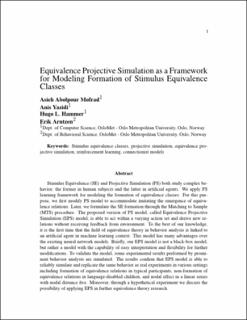| dc.description.abstract | Stimulus equivalence (SE) and projective simulation (PS) study complex behavior, the former in human subjects and the latter in artificial agents. We apply the PS learning framework for modeling the formation of equivalence classes. For this purpose, we first modify the PS model to accommodate imitating the emergence of equivalence relations. Later, we formulate the SE formation through the matching-to-sample (MTS) procedure. The proposed version of PS model, called the equivalence projective simulation (EPS) model, is able to act within a varying action set and derive new relations without receiving feedback from the environment. To the best of our knowledge, it is the first time that the field of equivalence theory in behavior analysis has been linked to an artificial agent in a machine learning context. This model has many advantages over existing neural network models. Briefly, our EPS model is not a black box model, but rather a model with the capability of easy interpretation and flexibility for further modifications. To validate the model, some experimental results performed by prominent behavior analysts are simulated. The results confirm that the EPS model is able to reliably simulate and replicate the same behavior as real experiments in various settings, including formation of equivalence relations in typical participants, nonformation of equivalence relations in language-disabled children, and nodal effect in a linear series with nodal distance five. Moreover, through a hypothetical experiment, we discuss the possibility of applying EPS in further equivalence theory research. | en_US |
